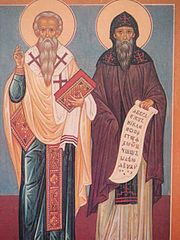| Revision as of 02:16, 29 May 2006 view sourceNedko (talk | contribs)262 edits rv, Hectorian, Telex, NikoSilver and Miskin, dont remove POV tag before compromise in discussion page. Refusing dispute participation is to not same as that POV is not disputed.← Previous edit | Revision as of 08:56, 29 May 2006 view source Evertype (talk | contribs)Autopatrolled, Extended confirmed users, File movers13,007 edits This is a fine article, and it is not appropriate to call it "disputed".Next edit → | ||
| Line 1: | Line 1: | ||
| {{POV}} | |||
| :<span class="dablink">''For other uses, see ].''</span> | :<span class="dablink">''For other uses, see ].''</span> | ||
| ].]] | ].]] | ||
Revision as of 08:56, 29 May 2006
- For other uses, see Cyril.

Cyril and Methodius were two Greek (i.e. Byzantine) brothers born in Thessaloniki in the 9th century, who became missionaries of Christianity in Khazaria and Great Moravia. They are credited with devising and spreading the Glagolitic alphabet, which was used for Slavonic manuscripts before the development of the Cyrillic, the alphabet derived from Glagolitic, that, with small modifications, is still used in a number of Slavic languages.
After their death their pupils became missionaries among other Slavic peoples.
Their father, Leon, was a military officer in the thema of Thessaloniki and their mother his wife Maria. Cyril's birth name was Constantine (Greek: Κωνσταντίνος Konstantínos) and he was probably renamed Cyril (Greek: 'Lordly') just before his death in Rome.
The two brothers lost their father at a young age, and their uncle Theoktistos (Greek: Θεόκτιστος) became their protector. Theoktistos was a "Logothetes tou dromou," a powerful Byzantine official, responsible for the postal services and the diplomatic relations of the Empire. He was also responsible, along with the regent Bardas, for initiating a far- reaching educational program within the Empire which founded the University of Magnaura, where Constantine/Cyril was to teach.
He invited (843) Cyril to Constantinople, the capital of the Byzantine Empire and helped him continue his studies at the University there.
Theoktistos also arranged the placement of Methodius (Greek: Μεθόδιος Methódios) as the commander of a Slavic administrative region of the Empire.
The fact that Cyril was a master theologian with a good command of both the Arabic and Hebrew languages made him eligible for his first state mission to the Abbasid Caliph Al-Mutawakkil in order to discuss the principle of the Holy Trinity with the Arab theologian and to tighten the diplomatic relations between the Abbashid Caliphate and the Empire.
The two brothers' second mission (860) by the Byzantine Emperor Michael III and the Patriarch of Constantinople Photius (a professor of Cyril's at the University and his guiding light in earlier years) was a missionary expedition to the Khazar Khagan in order to prevent the expansion of Judaism there. This mission was unsuccessful, as later the Khagan imposed Judaism to his people as the national religion.
After their return to Constantinople, Cyril assumed the role of professor of Philosophy in the University while Methodius had been designated as the bishop of the Moni Polychroniou.
In 862 they were invited by prince Rastislav to propagate Christianity in the Slavic language in Great Moravia, which they did until their deaths, Cyril's in 869 (in Rome) and Methodius' in885 (in Great Moravia). For the purpose of this mission, they devised the Glagolitic alphabet, an alphabet derived from the Greek alphabet and used for Slavonic manuscripts before the development of the Cyrillic, an alphabet derived from Glagolitic and the Greek alphabet, that with small modifications is still used in a number of Slavic languages. They also translated Christian texts for Slavs into the language that is now called Old Church Slavonic and wrote the first Slavic Civil Code, which was used in Great Moravia. The language derived from Old Church Slavonic, known as Church Slavonic, is still used in liturgy by several Eastern Orthodox churches. Both brothers were canonized in Eastern Orthodoxy as "equal-to-apostles" and were celebrated by the Roman Catholic Church in 1880. Pope John Paul II promoted them to Patrons of Europe in 1980.
The Cyrillic alphabet, used in several Slavic countries, was developed in the beginning of the 10th century, and was named so in honor of St. Cyril. Its probable creator is Clement of Ohrid, one of the closest disciples of the two holy brothers. Compared to the earlier Glagolitic alphabet, it uses letters closer to those of the Greek alphabet, but has been adapted for use in some fifty languages.

The common commemoration day for the two apostles in the Catholic, Evangelical Lutheran and Anglican Church is on February 14. The Eastern Orthodox Church has a commemoration day for Cyril on February 14 and for both brothers on May 11.
In the Czech lands and Slovakia, the two brothers were originally commemorated on March 9, but Pope Pius IX changed this date to July 5. Today, the St. Cyril and Methodius Day, believed to be the date of the arrival of the two brothers to Great Moravia in 863, is a national holiday both in the Czech Republic and Slovakia. Today, many Slavic countries consider May 24th the holiday associated with the two brothers, who are considered patrons of learning and education.
The saints' feast day is celebrated on May 24 as Saints Cyril and Methodius Day, which is a public holiday in Bulgaria and Macedonia; it is celebrated as a church festival in Russia.
For the separate articles on the two brothers, see:
See also
- Brotherhood of Saints Cyril and Methodius
- SS. Cyril and Methodius Seminary
- University SS. Cyril and Methodius
External links
- The Columbia Encyclopedia, Sixth Edition, Cyril and Methodius, Saints.
- 24 May - is the Day of Cyrillic Alphabet and St. Cyril and St. Methody
- Cyril and Methodius in the "Catholic Encyclopedia"
- "Equal to Apostles SS. Cyril and Methodius Teachers of Slavs", by Prof. Nicolai D. Talberg
- by Pope John Paul II